Earth
Young Giraffe Defies the Odds with Remarkable Recovery After Pionnering Surgery
The remarkable recovery followed a carefully coordinated wildlife rescue operation, which brought together experts from around the world to ensure the animal’s survival
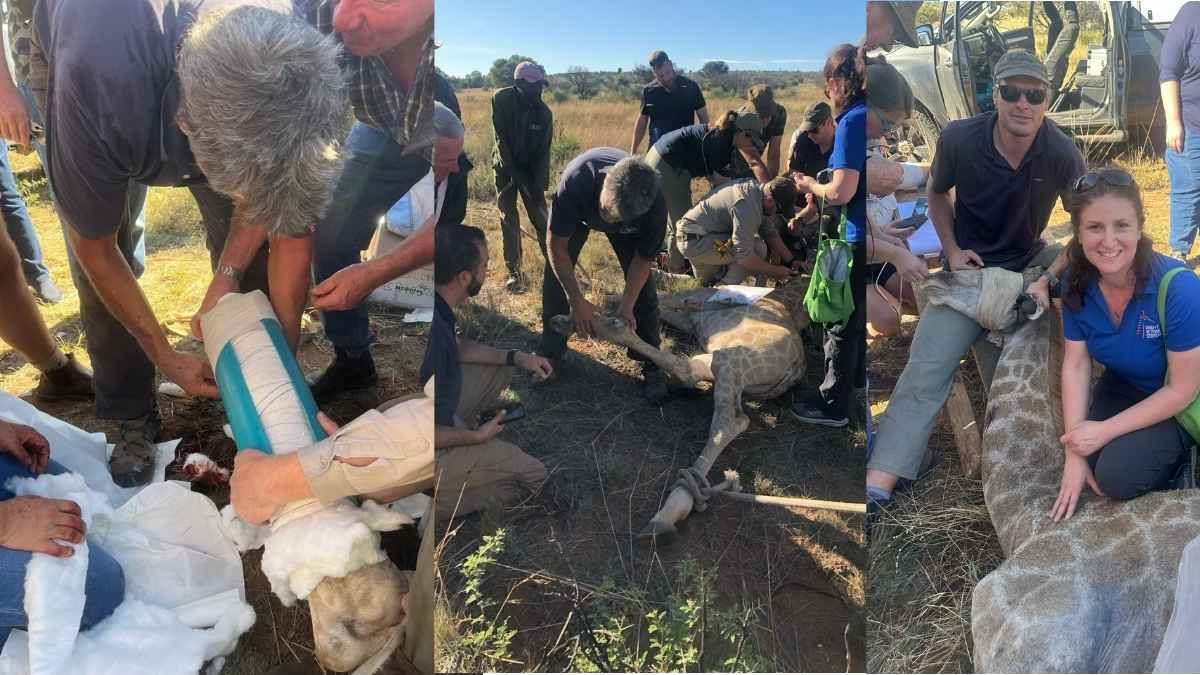
A young giraffe, initially given little chance of survival after suffering a severe leg injury, is now walking with his herd just one week after undergoing a pioneering surgical procedure. The remarkable recovery followed a carefully coordinated wildlife rescue operation, which brought together experts from around the world to ensure the animal’s survival.
According to Professor Francois Deacon from the Department of Animal Sciences at the University of the Free State (UFS), South Africa, the surgery, which took place on Wednesday, 19 February, was carried out on a remote game farm located between Dealesville and Boshof. The farm owner first noticed the young giraffe limping, suspecting a broken leg. Without hesitation, he contacted Dr. Andri Grobbelaar, a UFS PhD graduate specializing in giraffe healthcare and welfare.
The timing of the rescue was fortuitous, as a team of American veterinarians researching giraffe hoof health were visiting UFS, making them ideal collaborators for the operation.
Challenges of Performing Surgery in the Field
While the exact cause of the injury remains unclear, Professor Deacon speculates that the rough terrain on the farm may have contributed to the fracture. “The farm has rocky outcrops and uneven surfaces, so it’s possible the giraffe’s leg got caught between rocks or stepped into a warthog hole, leading to the fracture,” he explained.
Rescuing a wild giraffe, particularly in such a remote location, posed significant challenges. Immobilizing the animal safely required advanced capture techniques, and a team of five experienced wildlife veterinarians worked together to ensure the giraffe’s wellbeing. “The terrain made it difficult to get close enough to dart the giraffe, and once immobilized, we had to act quickly,” said Professor Deacon. Dr. Willem Daffue from the Kroonstad Animal Hospital led the surgical procedure, bringing his extensive experience in treating giraffes. “Time was critical, as prolonged immobilization could lead to severe health complications,” he added.
Surgical Procedure and Recovery
Upon examination, the veterinarians discovered the giraffe’s leg was severely damaged. The lower leg was loose and broken, with the risk that the bones could pierce the skin. Under sedation and local anaesthesia, the team cleaned the wound, removed the damaged bone fragments, and stabilized the leg using surgical stainless-steel pins. The leg was then reinforced with a thick splint supported by PVC pipes for added stability.
Professor Deacon highlighted the unique challenge of the procedure, as there were no existing references for splinting a giraffe’s leg in such a condition. To monitor the giraffe’s recovery with minimal disturbance, the team used drone technology to track the animal remotely.
Two American veterinarians, Dr. Liza Dadone and Dr. Steve Foxforth – both specialists in giraffe care from international zoo environments – played a key role in administering antibiotics and providing guidance on hoof care, further aiding the animal’s recovery.
A Promising Recovery
Just one week after surgery, the young giraffe is thriving and defying expectations. The game farm owner and staff have reported that the giraffe is walking with the herd and keeping pace with the others – a promising sign that his recovery is progressing well. “Over the next six to eight weeks, we will continue to monitor his condition. If healing progresses as expected, the splint will be removed, and he could have up to a 50% chance of making a full recovery,” said Professor Deacon.
The giraffe’s young age and relatively low body weight are contributing factors in his favor, giving hope that he may eventually return to full health. This extraordinary outcome is the result of a global collaboration, expert intervention, and an unwavering commitment to wildlife conservation.
Earth
Meltwater ponds might have sheltered life during earth’s deep freeze
During this time, the planet was believed to be encased in ice, with global temperatures plummeting to as low as -50°C
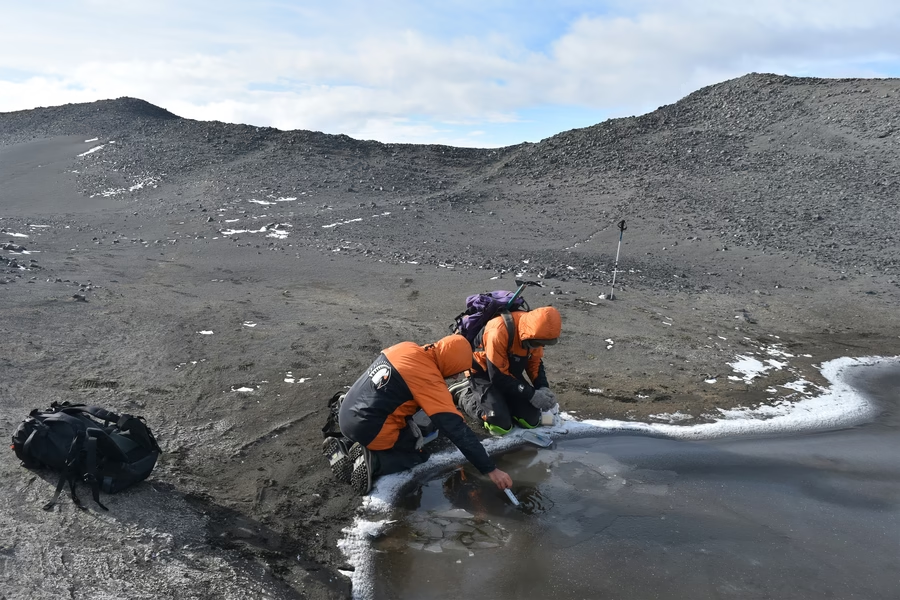
In a study published in Nature Communications, scientists from MIT have proposed that shallow meltwater ponds may have provided critical refuges for early complex life during one of Earth’s most extreme ice ages — the “Snowball Earth” period, which occurred between 635 and 720 million years ago.
During this time, the planet was believed to be encased in ice, with global temperatures plummeting to as low as -50°C. Despite the harsh conditions, complex cellular life — known as eukaryotes — managed to survive. The new research suggests that these life forms could have found sanctuary in small, briny pools formed on the surface of equatorial ice sheets.
“Meltwater ponds are valid candidates for where early eukaryotes could have sheltered during these planet-wide glaciation events,” said lead author Fatima Husain, a graduate researcher in MIT’s Department of Earth, Atmospheric and Planetary Sciences, in a media statement. “This shows us that diversity is present and possible in these sorts of settings. It’s really a story of life’s resilience.”
The team drew parallels between ancient equatorial ice sheets and modern Antarctic conditions. They studied contemporary meltwater ponds on Antarctica’s McMurdo Ice Shelf — an area first dubbed “dirty ice” by explorers in the early 20th century. These ponds, formed by sun-warmed dark debris trapped within surface ice, provided a modern analog to the possible melt environments of the Cryogenian Period.
Samples taken from these Antarctic ponds revealed clear signatures of eukaryotic life. Using chemical and genetic analysis, including the identification of sterols and ribosomal RNA, the researchers detected algae, protists, and microscopic animals — all descendants of early eukaryotes. Each pond supported unique communities, with differences shaped largely by salinity levels.
“No two ponds were alike,” Husain noted. “There are repeating casts of characters, but they’re present in different abundances. We found diverse assemblages of eukaryotes from all the major groups in all the ponds studied.”
These findings suggest that meltwater ponds — overlooked in previous hypotheses — could have served as vital “above-ice oases” for survival and even diversification during Snowball Earth.
“There are many hypotheses for where life could have survived and sheltered during the Cryogenian, but we don’t have excellent analogs for all of them,” Husain explained. “Above-ice meltwater ponds occur on Earth today and are accessible, giving us the opportunity to really focus in on the eukaryotes which live in these environments.”
The study was co-authored by MIT’s Roger Summons, Thomas Evans (formerly MIT), Jasmin Millar of Cardiff University, Anne Jungblut of the Natural History Museum in London, and Ian Hawes of the University of Waikato in New Zealand.
By uncovering how life may have persisted through Earth’s frozen past, the research not only deepens understanding of our planet’s history — it may also help inform the search for life on icy worlds beyond Earth.
Earth
In ancient India, mushy earth made for perfume scent
Kannauj, a city in the Indian state of Uttar Pradesh, offers a sustainable alternative in producing perfumes using traditional modes of distillation.
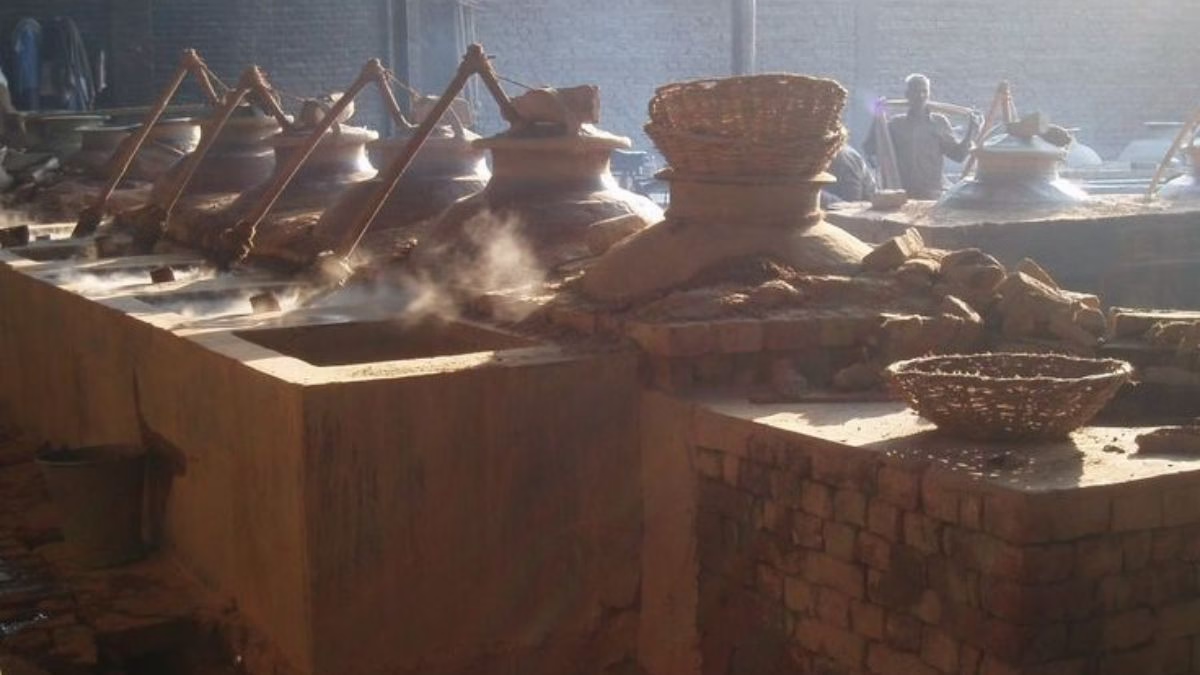
A sweet scent typically lingers around in the air at Kannauj, an ancient city in India’s most populous state of Uttar Pradesh. It’s an imprint of the countless occasions when it had rained, of roses that bloomed at dawn, and of sandalwood trees that once breathed centuries of calm.. Though mushy smells are not unique to Kannauj, the city utilized traditional distillation methods to make perfume out of these earthly scents.
Kannauj has had a longstanding tradition in perfume-making since four centuries ago. The city, colloquially known as the country’s ancient perfume capital, still uses rustic copper stills, wood-fired ovens, and bamboo pipes leading to sandalwood oil-filled vessels, or attar as it is colloquially known, to make their perfume. Though it gives a pre-industrial look, a closer peek would reveal an ecosystem of complex thermal regulation, plant chemistry, sustainability science, and hydro-distillation chemistry at work.
When synthetically-made but sustainable perfumes, and AI-generated ones share the spotlight today, Kannauj’s tryst with perfumes offer an alternative, sustainable model in traditional distillation, which is inherently low-carbon, zero-waste, and follow principles of a circular economy; all in alignment with sustainable development goals.
Traditional perfume-making is naturally sustainable
In industrial processing, hydro-distillation is a commonly done to separate substances with different boiling points. Heating the liquids produce vapors, which can later be liquefied in a separate chamber. Perfumers in Kannauj follow the same practice, except it promises to be more sustainable with the copper stills, a process colloquially known as dheg-bhakpa hydro-distillation.
There’s no alcohol or synthetic agents in use. Instead, they heat up raw botanicals – such as roses, vetiver roots, jasmine, or even sunbaked clay – to precise temperatures well short of burning, thereby producing fragrant vapor. The vapors are then guided into cooling chambers, where they condense and bond with a natural fixative, often sandalwood oil. Plant residue is the only byproduct, which finds use as organic compost to cultivate another generation of crops.

Trapping earthly scent to make perfume
In the past five years, Kannauj’s veteran perfumers noticed a quiet, but steady shift in their timely harvest and produce. Rose harvests have moved earlier by weeks. Vetiver roots grow shallower due to erratic rainfall. Jasmine yields are fluctuating wildly. The local Ganges river, which influences humidity levels essential for distillation timing, is no longer as predictable. For an entire natural aromatic economy built on seasonal synchrony, this uncertainty has rung alarm bells.
“The scent of a flower depends not just on the flower itself,” Vipin Dixit, a third-generation attar-maker whose family has distilled fragrance for decades, said to EdPublica.
“It depends on the weather the night before, on the heat at sunrise, on the moisture in the air. Even the soil has a scent-memory.”

As a result, perfumers in Kannauj have begun to adapt, applying traditional wisdom through a modern scientific lens. Local distillers are now working with botanists and environmental scientists to study soil microbiomes, measure scent compounds using chromatography, and develop community-based rainwater harvesting to ensure sustainable crop health.
One of the most surprising innovations is trapping petrichor — the scent of first rain — through earth attars. Clay is baked during extreme heat waves, mimicking summer conditions, then distilled to trap the scent of rain hitting dry soil. This aroma, called mitti attar, is one of the few scents in the world created from an environmental phenomenon; and not a flower.
At a time when the world is scrambling to save biodiversity, the humble attar may become a template for green chemistry — one that doesn’t just preserve scent, but also restores the relationship between science, nature, and soul.
Earth
A Region on the Edge: Ocean Heat, Island Peril, and a Global Wake-up Call
Real-world impacts in the South-West Pacific — from disappearing glaciers to cultural erosion in Fiji — illustrate what is at stake.

In a stark warning for the world, the World Meteorological Organization (WMO) released its latest report in June first week, The State of the Climate in the South-West Pacific 2024, painting a vivid picture of escalating climate extremes across ocean and land. The report, released to coincide with the 2025 Global Platform on Disaster Risk Reduction in Geneva and ahead of the 2025 UN Ocean Conference, warns that the South-West Pacific is already grappling with the climate future the rest of the world fears.
A record-breaking Year
2024 marked the warmest year on record for the region, driven by El Niño conditions and unprecedented ocean heating. Nearly 40 million square kilometers — over 10% of the global ocean surface — was scorched by marine heatwaves.
“2024 was the warmest year on record in the South-West Pacific region. Ocean heat and acidification combined to inflict long-lasting damage to marine ecosystems and economies. Sea-level rise is an existential threat to entire island nations. It is increasingly evident that we are fast running out of time to turn the tide,” said WMO Secretary-General Prof. Celeste Saulo in a recent media statement.
The heat was not limited to oceans. Extreme temperatures shattered records in Australia and the Philippines, increasing health risks and straining already vulnerable infrastructure.
Storms, floods, and vanishing ice
The report recounts an unprecedented cyclone season in the Philippines: 12 storms in just three months, affecting over 13 million people and displacing 1.4 million. Meanwhile, Indonesia’s last tropical glacier in New Guinea may vanish by 2026. Satellite estimates show a 30-50% ice loss since 2022.
Precipitation patterns swung to extremes. While Malaysia, Indonesia, and Papua New Guinea faced above-average rainfall and floods, parts of Australia and New Zealand were parched by drought.
The ocean in crisis
The annual sea surface temperature in 2024 was the highest since records began in the early 1980s. Combined with acidification and deoxygenation, ocean warming is devastating marine life and altering storm patterns.
Worryingly, the South-West Pacific sea-level rise already exceeds the global average, threatening islands where over half the population lives within 500 meters of the coast.
Displacement and cultural loss
The Fijian island of Serua, battered by floods and eroding shores, exemplifies the dire choices communities must make.
Despite government offers to relocate, many residents resist because of their deep connection to the land, or “vanua,” a concept embedding identity, spirituality, and ancestry.
“On two separate occasions, the island experienced such extreme flooding that it was possible to cross the entire island by boat without encountering land,” the WMO report said.
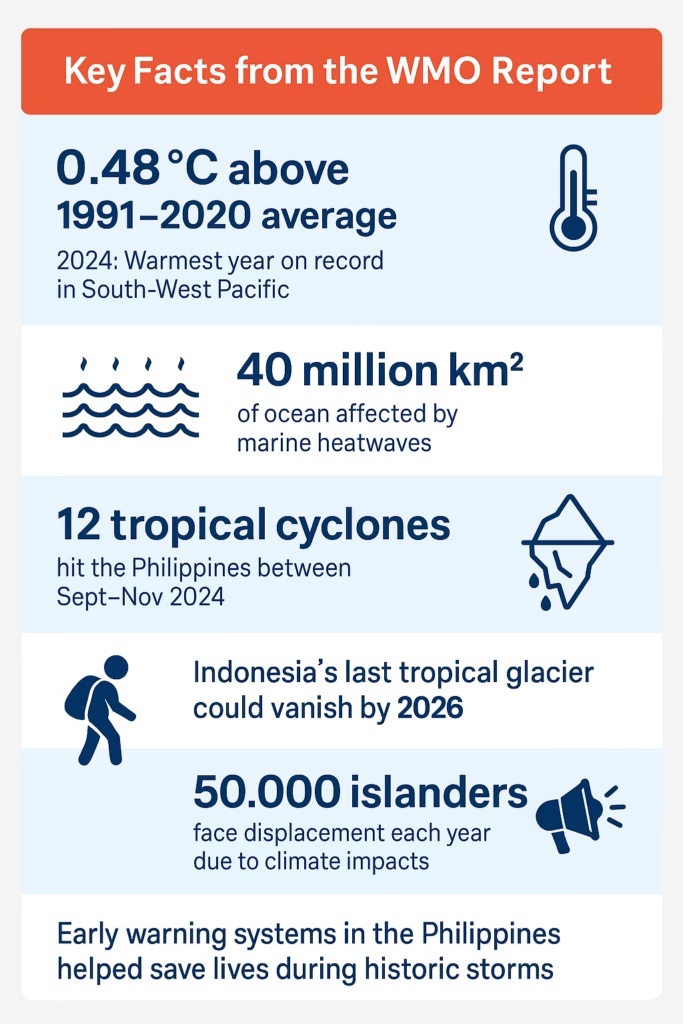
Hope in anticipation: Early warnings save lives
Not all is bleak. A case study from the Philippines showcased how early warning systems and anticipatory action helped mitigate the toll of the 2024 cyclone season. The Food and Agriculture Organization’s anticipatory action teams helped relocate fishing boats and distribute cash aid ahead of the storms.
“While the frequency of tropical cyclones may decrease, their intensity will rise. Building resilience is essential,” the report warns.
A Global Response: UNOC3 Signals Change, But Action Must Follow
As the WMO’s warnings echoed, the United Nations Ocean Conference (UNOC3) concluded in Nice, France (June 9-13, 2025), providing a parallel platform of hope and accountability.
- The High Seas Treaty reached 49 ratifications, nearing the 60 needed for enforcement.
- Nearly $10 billion in funding was pledged for ocean health, though experts note that the real need is $175 billion annually.
- Countries endorsed the 30×30 conservation goal and backed measures against deep-sea mining and plastic pollution.
“We must move from plunder to protection,” said UN Secretary-General António Guterres in his closing address.
These developments reinforce the urgency of the WMO findings. Real-world impacts in the South-West Pacific — from disappearing glaciers to cultural erosion in Fiji — illustrate what is at stake.
The South-West Pacific is not a distant front line. It is the epicenter of an unfolding climate reality. With international mechanisms like the High Seas Treaty nearing activation and early warning systems proving effective, the question is no longer whether we can respond — but whether we will act in time.
As the seas rise and the clock ticks, it’s not just islands at risk. It’s the future of global climate stability.
-

 Society4 months ago
Society4 months agoStarliner crew challenge rhetoric, says they were never “stranded”
-

 Space & Physics3 months ago
Space & Physics3 months agoCould dark energy be a trick played by time?
-
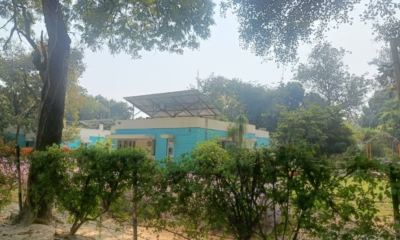
 Earth4 months ago
Earth4 months agoHow IIT Kanpur is Paving the Way for a Solar-Powered Future in India’s Energy Transition
-

 Space & Physics3 months ago
Space & Physics3 months agoSunita Williams aged less in space due to time dilation
-

 Learning & Teaching4 months ago
Learning & Teaching4 months agoCanine Cognitive Abilities: Memory, Intelligence, and Human Interaction
-

 Earth2 months ago
Earth2 months ago122 Forests, 3.2 Million Trees: How One Man Built the World’s Largest Miyawaki Forest
-

 Women In Science3 months ago
Women In Science3 months agoNeena Gupta: Shaping the Future of Algebraic Geometry
-

 Society5 months ago
Society5 months agoSustainable Farming: The Microgreens Model from Kerala, South India
























